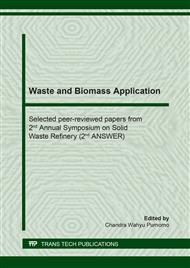[1]
Qiang, L., Wen-Zhi, L., & Xi-Feng, Z., Overview of fuel properties of biomass fast pyrolysis oils. Energy Conversion and Management, 50 (2009) 1376-1383.
DOI: 10.1016/j.enconman.2009.01.001
Google Scholar
[2]
Panda, A. K., Singh, R., & Mishra, D., Thermolysis of waste plastics to liquid fuel: A suitable method for plastic waste management and manufacture of value added products-A world prospective. Renewable and Sustainable Energy Reviews, (2009) 233-248.
DOI: 10.1016/j.rser.2009.07.005
Google Scholar
[3]
Ojha, D.K. and Vinu, R., Fast co-pyrolysis of cellulose and polypropylene using Py-GC/MS and Py-FT-IR. Royal Society of Chemistry Adv., 5 (2015) 66861-66870.
DOI: 10.1039/c5ra10820a
Google Scholar
[4]
Supramono, D., Julianto, Haqqyana, Setiadi and Nasikin, M., Phase separation of bio-oil produced by co-pyrolysis of corn cobs and polypropylene. IOP Conf. Series: Earth and Environmental Science, 93, 012072 (2017) 1-13.
DOI: 10.1088/1755-1315/93/1/012072
Google Scholar
[5]
Zhang, X., Lei, H., Chen, S. and Wu, J. Catalytic co-pyrolysis of lignocellulosic biomass with polymers: a critical review. Green Chemistry, 18(15) (2016) 4145-4169.
DOI: 10.1039/c6gc00911e
Google Scholar
[6]
Suriapparao, D. V., & Ojha, D. K., Kinetic analysis of co-pyrolysis of cellulose and polypropylene. Journal of Thermal Analysis and Calorimetry. (2014).
DOI: 10.1007/s10973-014-3866-4
Google Scholar
[7]
Lee, K.-H, Thermal and catalytic degradation of waste HDPE. In J. Scheirs, & W. Kaminsky (Orgs.), Feedstock recycling and pyrolysis of waste plastics (pp.129-160). Hoboken: John Wiley & Sons (2006).
DOI: 10.1002/0470021543.ch5
Google Scholar
[8]
Almeida, D. and Marques, M.d.F., Thermal and catalytic pyrolysis of plastic waste. Polímeros, 26(1) (2016) 44-51.
DOI: 10.1590/0104-1428.2100
Google Scholar
[9]
Kim, J.R., Yoon, J.H., Park, D.W., Catalytic recycling of the mixture of polypropylene and polystyrene. Polym. Degrad. Stab., 76 (2002) 61–67.
Google Scholar
[10]
Zeaiter, J., A process study on the pyrolysis of waste polyethylene. Fuel, 133 (2014) 276–282.
DOI: 10.1016/j.fuel.2014.05.028
Google Scholar
[11]
Guda, V.K. and Toghiani, H., Altering bio-oil composition by catalytic treatment of pine wood pyrolysis vapors over zeolites using an auger-packed bed integrated reactor system. Biofuel Research Journal, 11 (2016), 448-457.
DOI: 10.18331/brj2016.3.3.4
Google Scholar
[12]
Aho, A., Kumar, N., Eränen, K., Salmi, T., Hupa, M., Murzin, D.Y., Catalytic pyrolysis of biomass in a fluidized bed reactor: influence of acidity of H-beta zeolite. IChemE, part B, Process Safety and Environmental Protection, 85 (2007) 473-480.
DOI: 10.1205/psep07012
Google Scholar
[13]
Hensen, E. J. M., Poduval, D. G., Degirmenci, V., Ligthart, D., Chen, W.B., Mauge, F., Rigutto, M.S., van Veen, J.A.R., Acidity characterization of amorphous silica-alumina. Journal of Physical Chemistry C., 116 (2012) 21416-21429.
DOI: 10.1021/jp309182f
Google Scholar
[14]
Thangalazhy-Gopakumar S., Adhikari, S. and Gupta, R.B., Catalytic pyrolysis of biomass over HZSM-5 under hydrogen pressure. Energy Fuels 26 (2012) 5300-5306.
DOI: 10.1021/ef3008213
Google Scholar
[15]
Miandad, R., Barakat, M.A., Rehan, M., Aburiazaiza, A.S., Ismail, I.M.I., Nizami, A.S., Plastic waste to liquid oil through catalytic pyrolysis using natural and synthetic zeolite catalysts. Waste Management, 69 (2017) 66-78.
DOI: 10.1016/j.wasman.2017.08.032
Google Scholar
[16]
Zhang, X., Lei, H., Chen, S., & Wu, J., Catalytic co-pyrolysis of lignocellulosic biomass with polymers: a critical review. Green Chemistry, 18 (15) (2016) 4145-4169.
DOI: 10.1039/c6gc00911e
Google Scholar
[17]
Tchapda, A.H. and Pisupati, S.V., A Review of thermal co-conversion of coal and biomass/waste. Energies, 7 (2014) 1098-1148.
DOI: 10.3390/en7031098
Google Scholar
[18]
Yang, H., Yan, R., Chen, H., Lee, D.H., Zheng, C., Characteristics of hemicellulose, cellulose and lignin pyrolysis. Fuel, 86 (2007), 1781-1788.
DOI: 10.1016/j.fuel.2006.12.013
Google Scholar
[19]
Zhang, L, Bao, Z., Xia, S., Lu, Q. and Walters, K.B., Catalytic pyrolysis of biomass and polymer wastes. Catalysts, 8 (2018) 659.
DOI: 10.3390/catal8120659
Google Scholar
[20]
Wang, Y., Li, X., Mourant, D., Gunawan, R., Zhang, S. and Li, C.-Z., Formation of aromatic structures during the pyrolysis of bio-oil. Energy Fuels, 26 (2012) 241–247.
DOI: 10.1021/ef201155e
Google Scholar
[21]
Pyra, K., Tarach, K.A., Majda, D. and Góra-Marek, K., Desilicated zeolite BEA for the catalytic cracking of LDPE: the interplay between acid sites' strength and accessibility. Catal. Sci. Technol.,.
DOI: 10.1039/c9cy00326f
Google Scholar



